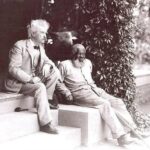
In 1903, on his last visit to his in-laws at Quarry Farm in Elmira, New York, Mark Twain (1835-1910) posed for this photograph with his friend, John T. Lewis (1835-1906), who was born a free man in Maryland and who had migrated to upstate New York.
They met in 1877 after Lewis saved the lives of Twain’s sister-in-law and her daughter by courageously stopping their runaway carriage at no small risk to his own safety. Lewis was an Elder in the Church of the Brethren (the Dunkers), and he and Twain often talked about religion and other such matters. Lewis loved to read, and Twain would send him every one of his books when they came out, with a loving inscription in each one. After Lewis retired from farming, Twain and his in-laws arranged to have him receive a pension.
When Twain returned to writing Huckleberry Finn, in 1879 while at Elmira, Lewis was one of the real-life people upon whom he based the character of Jim, and it is even possible that his acquaintance with Lewis caused Twain to continue working on the novel after having earlier set it aside.
Twain’s friendship with Lewis was hardly atypical; of all the white authors in this period, he was the one most fully immersed in and appreciative of African American culture and the one most at home in the company of African Americans. Near the end of his life he recalled a time in New York City when he was walking with another black friend, George Griffin, and people stared at them: “a ‘white man’ & a negro walking together was a new spectacle to them. The glances embarrassed George, but not me, for the companionship was proper: in some ways he was my equal, in some others my superior.”
Published in 1884/1885, Huckleberry Finn is about a racist boy’s realization of the full humanity of a fugitive slave. Ten years later, in Pudd’nhead Wilson, Twain would deconstruct the very idea of race itself as nothing more than “a fiction of law and custom” without any basis in biology. As Toni Morrison stated, “Mark Twain talked about racial ideology in the most powerful, eloquent, and instructive way I have ever read.”
Mark Twain and John T. Lewis are both buried with their families in Woodlawn Cemetery in Elmira.










Leave a Reply